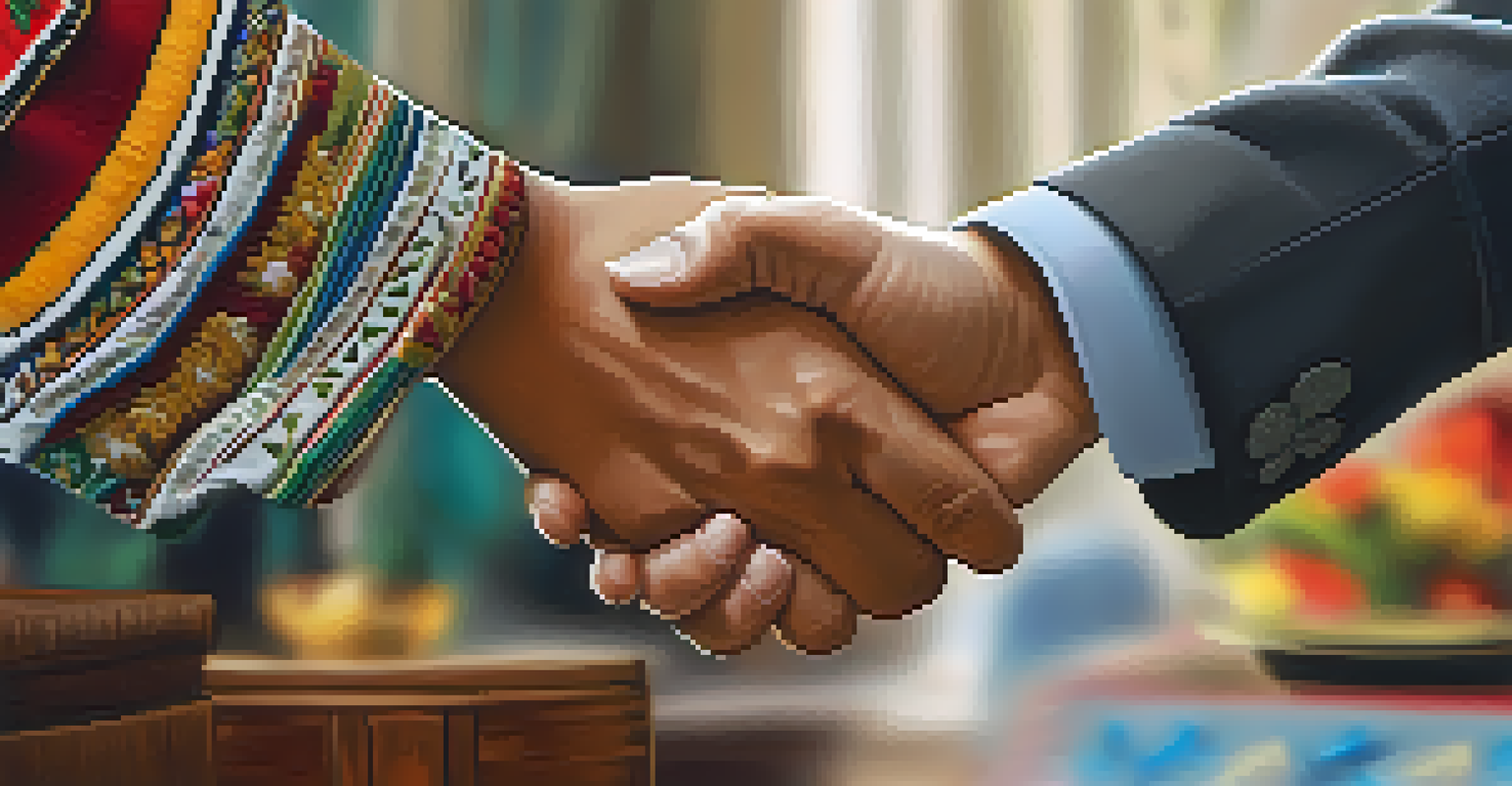Understanding Greetings: How to Properly Greet Peruvians

The Importance of Greetings in Peruvian Culture
Greetings are more than just polite exchanges in Peru; they're a way of showing respect and building relationships. In a culture where personal connections are valued, how you greet someone can set the tone for your entire interaction. A warm greeting is often seen as a reflection of your character and intentions.
A warm smile is the universal language of kindness.
In Peru, greetings can vary widely depending on the context, so understanding these nuances is essential. For example, a casual 'Hola' may suffice among friends, but a more formal 'Buenos días' is appropriate in professional settings. This flexibility showcases the rich tapestry of social interactions in Peruvian culture.
Moreover, greetings often involve physical gestures such as handshakes or cheek kisses, which further emphasize the importance of personal connection. Therefore, taking the time to learn about these customs can help you navigate social situations more smoothly and leave a positive impression.
Common Greetings Used in Peru
In Peru, some common greetings include 'Hola' (Hello), 'Buenos días' (Good morning), 'Buenas tardes' (Good afternoon), and 'Buenas noches' (Good evening). Each greeting is used based on the time of day, reflecting a level of politeness and respect. It’s essential to match your greeting to the appropriate context to make a good impression.

When greeting someone for the first time or in a formal situation, a handshake is customary. This gesture conveys seriousness and respect, making it a great way to start a conversation. However, among friends and family, you may encounter cheek kisses, typically two, starting with the right cheek.
Greetings Reflect Relationships
In Peru, greetings are vital for showing respect and establishing personal connections.
Understanding these greetings can help you feel more comfortable in social situations. By using the right phrases and gestures, you demonstrate your willingness to embrace Peruvian culture, which can foster deeper connections with the people you meet.
The Role of Body Language in Greetings
Body language plays a crucial role in how greetings are perceived in Peru. A friendly smile and eye contact can significantly enhance your greeting, making it feel more genuine. Remember, your non-verbal cues often speak louder than words, so be mindful of your demeanor.
The greatest gift of human beings is that we have the power of empathy.
When meeting someone, it’s common to lean slightly forward while extending your hand for a handshake or moving in for a cheek kiss. This closeness indicates openness and friendliness, which are valued traits in Peruvian society. The warmth you express through body language can help bridge cultural gaps.
Additionally, avoid crossing your arms or appearing disinterested, as these can be interpreted as signs of aloofness. Instead, adopt an open posture and engage fully in the greeting process. This attention to body language not only enhances your interactions but also fosters mutual respect.
When to Use Formal vs. Informal Greetings
Understanding when to use formal versus informal greetings is essential in Peru. Generally, formal greetings are reserved for professional settings or when meeting someone older or of higher status. In these situations, using 'Señor' or 'Señora' followed by the person’s last name can show respect.
Conversely, informal greetings are typically used among friends, family, or peers. In these contexts, you can feel free to use first names and casual phrases like '¿Qué tal?' (How’s it going?). This flexibility helps create a relaxed atmosphere and encourages open conversation.
Greetings Reflect Respect in Peru
In Peruvian culture, greetings are crucial for showing respect and establishing personal connections.
Navigating these distinctions can sometimes be tricky, especially for newcomers. However, observing how locals interact can provide valuable insights, allowing you to adapt your greeting style accordingly and foster better relationships along the way.
Cultural Nuances to Keep in Mind
In Peru, cultural nuances can influence how greetings are perceived. For instance, addressing people by their titles or last names initially is a sign of respect. This is especially important in formal situations, where a little extra politeness goes a long way in establishing rapport.
Additionally, be mindful of personal space. While some cultures may prefer more distance during greetings, Peruvians often appreciate closeness, especially among friends. This can mean a quick hug or a friendly pat on the back, signaling warmth and connection.
Being aware of these cultural nuances not only enhances your interactions but also demonstrates your respect for Peruvian traditions. It shows that you’re invested in understanding their culture, which can lead to more meaningful connections.
Online Greetings: Navigating Digital Communication
In today’s digital age, knowing how to greet someone online is just as important as in-person interactions. In Peru, starting an email or message with a friendly salutation, like 'Hola' or 'Estimado/a' (Dear), sets a positive tone. This simple gesture can help establish rapport, even before the conversation begins.
When using social media platforms, a casual approach is often welcomed. Using emojis or exclamation points can convey enthusiasm and friendliness, making your online presence feel more approachable. However, it’s still essential to maintain some formality in professional contexts.
Body Language Enhances Greetings
Non-verbal cues like smiles and eye contact play a significant role in making greetings feel genuine.
As digital communication continues to evolve, adapting your greetings to suit the platform and audience becomes crucial. By being aware of these online etiquette nuances, you can navigate virtual interactions with ease and foster better relationships, even from afar.
Overcoming Greeting Mistakes: What to Do
Even with the best intentions, mistakes can happen when greeting someone in Peru. If you accidentally use the wrong greeting or misread a social cue, don’t panic! A simple apology and a light-hearted acknowledgment of the mistake can often diffuse any awkwardness.
Many Peruvians appreciate the effort you put into learning their customs, even if you stumble along the way. Sharing a laugh or expressing your eagerness to learn can help turn a potentially embarrassing moment into a bonding experience.

Remember, cultural exchanges are all about growth and understanding. By taking these missteps in stride, you not only show your adaptability but also your genuine interest in connecting with others, which is truly what greetings are all about.